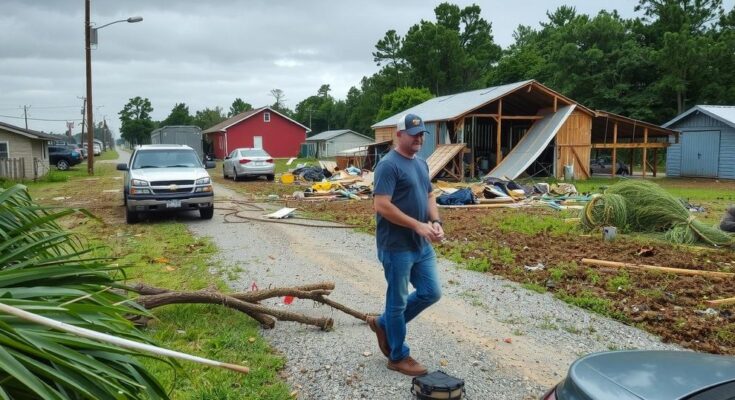Georgia farmers continue to face significant challenges two months after Hurricane Helene resulted in losses exceeding $5.5 billion. The storm caused widespread destruction of crops and infrastructure, leaving many questioning their future in agriculture. Emergency response measures are being implemented, yet the recovery process appears daunting for those affected.
Farmers in Georgia continue to suffer from the staggering impacts of Hurricane Helene, which caused significant damage over two months ago. The hurricane, classified as a major Category 4 storm, wreaked havoc across the South, resulting in losses estimated at $5.5 billion in Georgia alone. Many farmers are still coping with the emotional and financial aftermath, as fields remain littered with debris from destroyed infrastructure, including irrigation systems, grain bins, and poultry houses.
Chris Hopkins, a farmer in Toombs County, described the tumultuous feelings he has faced since the storm’s devastation. “Do we just get through this one and quit? Do we build back? It is emotionally draining,” he explained. With many farmers, including Hopkins, actively trying to salvage their crops during the cleanup, the storm’s timing was particularly detrimental as it struck at the onset of the fall harvest.
The total economic toll from Hurricane Helene has reached alarming figures, with experts estimating damages to agribusinesses ranging from Florida to Virginia in excess of $10 billion. This includes direct losses in crops, timber, and farm equipment, as well as indirect costs associated with decreased productivity facilities like cotton gins and poultry operations. Such losses have left many farmers questioning their futures and considering the viability of continuing their agricultural enterprises.
Hurricane Helene has exacerbated existing struggles for Georgia’s farmers, many of whom were already burdened by low prices and previous storm damages. The state’s government has prioritized emergency aid, redirecting $100 million to assist farmers and their recovery efforts. Additionally, a recent congressional spending bill allocated $21 billion in disaster assistance to support U.S. farmers impacted by various disasters.
While the storm’s destruction poses immediate challenges for farmers like Jeffrey Pridgen, who lost several chicken houses and thousands of livestock, agricultural economists suggest that consumer prices may not see a significant impact due to the productivity of other regions compensating for local losses.
Hurricane Helene, which made landfall on September 26 as a Category 4 storm, caused extensive destruction in the Southeastern United States, particularly impacting the agricultural sector. The storm’s timing was critical, as it coincided with the crucial fall harvest. Farmers were already facing a landscape shaped by economic challenges, including persistently low market prices for crops. The federal and state governments are working to provide necessary relief to allow farmers to recover and rebuild following the extensive damages incurred.
In summary, Hurricane Helene has inflicted severe damage on Georgia’s agricultural landscape, with farmers facing an estimated $5.5 billion in losses. The emotional and financial toll is substantial, prompting calls for immediate assistance as recovery efforts begin. While support from state and federal levels is underway, the long road to recovery poses questions about the future sustainability of impacted farming operations. Ultimately, the resilience of these farmers will be tested in the coming months as they navigate the challenges ahead.
Original Source: ktxs.com




